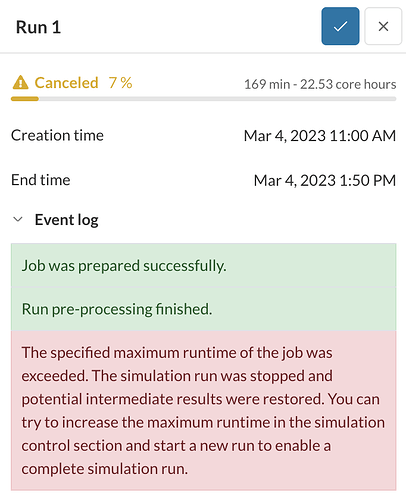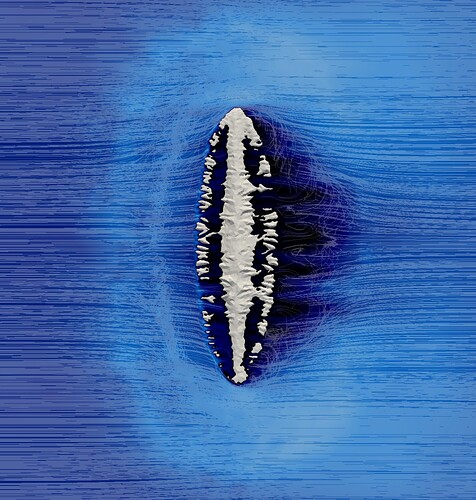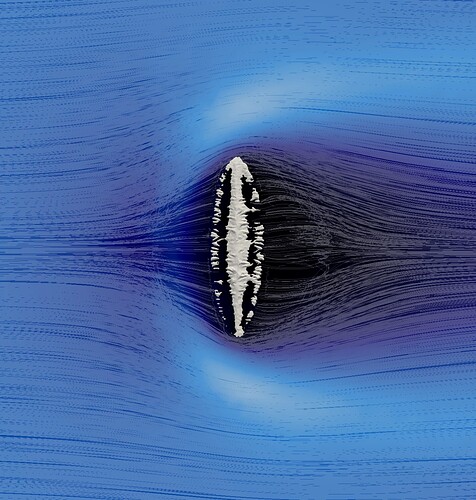Hi all,
I am trying to model a flow of 0.1m/s over a geometry resembling a precambrian fossil for my PhD. I have successfully modelled laminar and k-omega SST simulations. However, the k-omega SST simulation does not seem to pick up on eddying properly so I was trying to use LES simulations. These simulations eventually get stuck and I get the error you see in the attached image. I have tried increasing the maximum runtime but nothing seems to work. Before I run the simulations the expected duration is something like 52 - 78 min and 6.9 - 10.4 core hours but it is never the case. What do I have to do to make LES simulations work? Am I doing something wrong? I tried following public projects as well and nothing is working.
Here is the link to my project:
I also don’t fully understand why using laminar instead of k-omega SST would pick up on eddying better. See the two images below.
This is the laminar:
And this is the k-omega SST one:
I hope someone can help me and thank you everyone for your time in advance.
Dear @cfdseptoset, there are many things to comment on, and I will be overly direct in some of them as you are a Ph.D. candidate.
I strongly advise you to work more on your CFD theory, especially if your area is fluid mechanics; otherwise, you surely will fall into trouble later on. Here are some quick things to point out:
-
How can you tell there is a problem? The solver is running fine. It is just taken too many time steps as the dt is 2e-5. You’ve just run out of the “expected” time to solve the problem.
-
To point out there is a problem, you need to find one. For example, if you expected a larger dt size, I’d ask you if you verified the smallest cell size and calculated a step size (dt) based on your bulk-flow velocity. Is it coherent with the simulation dt?
-
LES has precise grid requirements. Did you work your grid to fulfill them? Especially regarding element size vs. Y+ values. LES is a potent turbulence model with many case/tuning requirements to achieve good results.
-
Large maxCo numbers on a grid with a rough surface and inadequate for LES may generate artificial oscillations, ultimately resulting in lower dt numbers. Do not use an automatic grid but create a parametric-hex one. Create boundary layers, etc.
-
Regarding the other things you mention ( “why using laminar instead of k-omega SST would pick up on eddying better”), how can you tell what is picking up on “eddying better”? The laminar model has no turbulent viscosity term; therefore, it would likely predict a longer distance for the detached region to merge. The SST-k-omega is a RANS turbulence model where additional transport equations are resolved to “assess” that artificial RANS turbulent viscosity term and make the detached flow merge within a shorter distance, especially with a “spiked” geometry upstream.
That’s all I can tell you at the moment. You will need lots of hard work (in CFD theory and practices) to make this work well.
Best regards,
Jairo
Hi Jairo,
To begin with, my area is obviously not fluid mechanics. My area is palaeontology as you can guess from the beginning of my message. So yes, my knowledge on the theory behind CFD is very limited; especially because I have never worked on anything related to CFD before. I am, just trying some ideas out, coming from a very different field.
By a “problem” I thought is was clear that I meant that I couldn’t complete the simulation.
If you have any concrete measure to make the simulation work, let me know. I do not understand many of the things you posted, because I do not have the knowledge. Again, I was just trying some ideas to understand my fossils from a different perspective. I would just like to be able to visualize the final results from the LES simulation even though they might be rudimentary and superfluous .
Best
I’m sorry if my last post sounded scathing; you have to understand I did not know your specific field, and I was trying to give you a hand in the long run by pointing out questions like any Ph.D. evaluator would do.
I would like to ask you: What do you want to achieve? Just visualize? are you going to make a comparison between 2 fossils? Will you measure drag (resistance to move) in the fluid for 2 different animals? This is to give you some tips.
The solution is further increasing the runtime to about 20 times what you had initially set. You can keep running the cases when runtime runs out by extending it. It will be costly. For the total physical simulation time, your value of 4 seconds is appropriate for your current setup. The issue is the runtime which represents how much time the computers will spend trying to simulate those 4 seconds of physical time.
No problem at all. But yes, I have no previous experience with CFD at all. Here is what I am trying to test:
During my PhD I have been conducting some cluster analysis with several variables including orientation. I found different orientation groups in respect to a paleocurrent in different organisms (different geometries). What I would like to visualize is how the current behaves when exposed to these different orientation groups and geometries. I would like to visualize change in velocity magnitude, eddying, and drag so I can study the implications when it comes to feeding (likely suspension-feeding organisms) and current-related damage.
I guess that if the solution is to extend runtime, then I would need to upgrade my account right? I believe the maximum is 30.000s.
Thank you for the answer
Dear @cfdseptoset, yes, you must extend the runtime (the time during which the case can run on the computers). I am not sure about the maximum runtime for free accounts (someone from SimScale can answer that), but I guess, in any case, you should upgrade your account.
I understand the approach correctly, and I will give you my opinion. With what you are doing, you could get some results that give you a general idea of how different organisms react to water currents, i.e., visualize wakes, visualize some velocity fields, etc. But you need more CFD knowledge, from a theoretical point of view, to give you robustness and more certainty in those results because they are likely to have errors. That means that if you can simulate some vortices, we are unsure if the simulated behavior will resemble the real one since some “standard CFD practices” are not followed.
What are your specific requirements for your thesis objectives? Can you hire in your workgroup master students in fluids with a focus on CFD? or do you have the means to hire help in that case? This would help you to obtain fully quantitative response variables. Some examples of these are the change in turbulence downstream of different organisms (e.g., turbulent kinetic energy), to collecting statistics of particles (tiny organisms) passing near the “mouth” of other organisms after overcoming an obstacle. The latter is more complex and is my area of expertise in CFD (particle dispersion in turbulent flow).
I hope this helps,
Jairo



